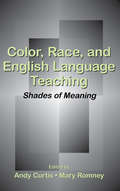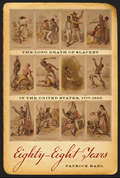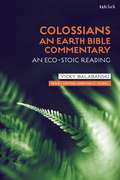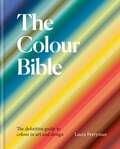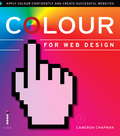- Table View
- List View
Color, Race, and English Language Teaching: Shades of Meaning
by Andy Curtis Mary RomneyThe unique contribution of this book is to bring together Critical Race Theory and narrative inquiry and apply them specifically to a largely overlooked area of experience within the field of TESOL: What does it mean to be a TESOL professional of color? To address this question, TESOL professionals of color from all over the world, representing a wide range of racial, ethnic, and cultural backgrounds, offer accounts of their own experiences, responding to two related questions:*Can you identify critical events or conditions in your personal or professional life that are the result of you being a person of color that affect who you are now and what you do as a TESOL professional of color?*What have you learned from these events or conditions that have had a bearing on your life as a TESOL professional of color? Color, Race, and English Language Teaching: Shades of Meaning is intended for researchers, professionals, and students in the field of English language teaching. The book is designed as a text for MATESOL programs and courses that deal with issues of language, culture, and teaching. The introduction presents a brief overview of relevant aspects of Critical Race Theory, narrative inquiry, and educational research. Focus questions for each chapter are included to help readers apply aspects of the narratives to their own experience.
Color, Race, and English Language Teaching: Shades of Meaning
by Andy Curtis Mary RomneyThe unique contribution of this book is to bring together Critical Race Theory and narrative inquiry and apply them specifically to a largely overlooked area of experience within the field of TESOL: What does it mean to be a TESOL professional of color? To address this question, TESOL professionals of color from all over the world, representing a wide range of racial, ethnic, and cultural backgrounds, offer accounts of their own experiences, responding to two related questions:*Can you identify critical events or conditions in your personal or professional life that are the result of you being a person of color that affect who you are now and what you do as a TESOL professional of color?*What have you learned from these events or conditions that have had a bearing on your life as a TESOL professional of color? Color, Race, and English Language Teaching: Shades of Meaning is intended for researchers, professionals, and students in the field of English language teaching. The book is designed as a text for MATESOL programs and courses that deal with issues of language, culture, and teaching. The introduction presents a brief overview of relevant aspects of Critical Race Theory, narrative inquiry, and educational research. Focus questions for each chapter are included to help readers apply aspects of the narratives to their own experience.
Color Struck: How Race and Complexion Matter in the “Color-Blind” Era (Teaching Race and Ethnicity)
by Lori Latrice Martin Hayward Derrick Horton Cedric Herring Verna M. Keith Melvin ThomasSkin color and skin tone has historically played a significant role in determining the life chances of African Americans and other people of color. It has also been important to our understanding of race and the processes of racialization. But what does the relationship between skin tone and stratification outcomes mean? Is skin tone correlated with stratification outcomes because people with darker complexions experience more discrimination than those of the same race with lighter complexions? Is skin tone differentiation a process that operates external to communities of color and is then imposed on people of color? Or, is skin tone discrimination an internally driven process that is actively aided and abetted by members of communities of color themselves? Color Struck provides answers to these questions. In addition, it addresses issues such as the relationship between skin tone and wealth inequality, anti-black sentiment and whiteness, Twitter culture, marriage outcomes and attitudes, gender, racial identity, civic engagement and politics at predominately White Institutions. Color Struck can be used as required reading for courses on race, ethnicity, religious studies, history, political science, education, mass communications, African and African American Studies, social work, and sociology.
Color Theory For Dummies
by Eric HibitChoose the right colors and color combinations for your projects Color theory is the art and science of using color. Color Theory For Dummies explains, in simple terms, how colors relate to one another and how they can be combined to work together in an aesthetically pleasing way. An understanding of color theory can help you create art, decorate your home, design a beautiful wedding, and impress your friends at parties. With this book, you’ll learn how humans perceive color, how colors harmonize or clash with each other, and how you can apply these principles in your life and work to add a little, well, color to things. Discover the history and science behind how we see colors Understand how colors mix, match, and contrast so you can create better color combinations Learn how certain colors have the ability to affect how we feel and think Apply color theory to design, art, décor, photography, and beyondColor Theory For Dummies simplifies and illuminates the world of color theory, outlining and defining color in a digestible and applicable way.
Color Theory For Dummies
by Eric HibitChoose the right colors and color combinations for your projects Color theory is the art and science of using color. Color Theory For Dummies explains, in simple terms, how colors relate to one another and how they can be combined to work together in an aesthetically pleasing way. An understanding of color theory can help you create art, decorate your home, design a beautiful wedding, and impress your friends at parties. With this book, you’ll learn how humans perceive color, how colors harmonize or clash with each other, and how you can apply these principles in your life and work to add a little, well, color to things. Discover the history and science behind how we see colors Understand how colors mix, match, and contrast so you can create better color combinations Learn how certain colors have the ability to affect how we feel and think Apply color theory to design, art, décor, photography, and beyondColor Theory For Dummies simplifies and illuminates the world of color theory, outlining and defining color in a digestible and applicable way.
Colormute: Race Talk Dilemmas in an American School
by Mica PollockThis book considers in unprecedented detail one of the most confounding questions in American racial practice: when to speak about people in racial terms. Viewing "race talk" through the lens of a California high school and district, Colormute draws on three years of ethnographic research on everyday race labeling in education. Based on the author's experiences as a teacher as well as an anthropologist, it discusses the role race plays in everyday and policy talk about such familiar topics as discipline, achievement, curriculum reform, and educational inequality. Pollock illustrates the wide variations in the way speakers use race labels. Sometimes people use them without thinking twice; at other moments they avoid them at all costs or use them only in the description of particular situations. While a major concern of everyday race talk in schools is that racial descriptions will be inaccurate or inappropriate, Pollock demonstrates that anxiously suppressing race words (being what she terms "colormute") can also cause educators to reproduce the very racial inequities they abhor. The book assists readers in cultivating a greater understanding of the pitfalls and possibilities of everyday race talk and clarifies previously murky discussions of "colorblindness." By bridging the gap between theory and practice, Colormute will be enormously helpful in fostering ongoing conversations about dismantling racial inequality in America.
Colormute: Race Talk Dilemmas in an American School (PDF)
by Mica PollockThis book considers in unprecedented detail one of the most confounding questions in American racial practice: when to speak about people in racial terms. Viewing "race talk" through the lens of a California high school and district, Colormute draws on three years of ethnographic research on everyday race labeling in education. Based on the author's experiences as a teacher as well as an anthropologist, it discusses the role race plays in everyday and policy talk about such familiar topics as discipline, achievement, curriculum reform, and educational inequality. Pollock illustrates the wide variations in the way speakers use race labels. Sometimes people use them without thinking twice; at other moments they avoid them at all costs or use them only in the description of particular situations. While a major concern of everyday race talk in schools is that racial descriptions will be inaccurate or inappropriate, Pollock demonstrates that anxiously suppressing race words (being what she terms "colormute") can also cause educators to reproduce the very racial inequities they abhor. The book assists readers in cultivating a greater understanding of the pitfalls and possibilities of everyday race talk and clarifies previously murky discussions of "colorblindness." By bridging the gap between theory and practice, Colormute will be enormously helpful in fostering ongoing conversations about dismantling racial inequality in America.
The Colors of Life: Exploring Life Experience Through Color and Emotion
by Marcia BrennanThe Colors of Life engages the strategies of Social and Emotional Learning (SEL) to explore life experience through emotion and color. For high-potential readers at the middle school level, the book’s humanistic and emotional themes provide valuable complements to the education of STEM-oriented learners.The book presents color as a vehicle of knowledge and empowerment to foster mindfulness, wisdom, and creative expression in young people. Featuring more than 50 original illustrations, the book’s core concepts are reinforced through complementary expressions of language and imagery.With an accompanying Guide for Teachers and Parents, the book can be accessed individually by independent readers, or it can be used as a teacher-led initiative with creative exercises to be implemented in the classroom.
The Colors of Life: Exploring Life Experience Through Color and Emotion
by Marcia BrennanThe Colors of Life engages the strategies of Social and Emotional Learning (SEL) to explore life experience through emotion and color. For high-potential readers at the middle school level, the book’s humanistic and emotional themes provide valuable complements to the education of STEM-oriented learners.The book presents color as a vehicle of knowledge and empowerment to foster mindfulness, wisdom, and creative expression in young people. Featuring more than 50 original illustrations, the book’s core concepts are reinforced through complementary expressions of language and imagery.With an accompanying Guide for Teachers and Parents, the book can be accessed individually by independent readers, or it can be used as a teacher-led initiative with creative exercises to be implemented in the classroom.
The Colossian Controversy: Wisdom in Dispute at Colossae (The Library of New Testament Studies #96)
by Richard DeMarisIdentifying the group or position that the author of Colossians attacks in ch 2 of that letter has long occupied scholars, but no interpretative consensus has resulted. This study details the inadequacy of existing reconstructions and offers in their stead the portrait of philosophically inclined Gentiles drawn to the Jewish community and then to the Christian congregation by ideas and practices congenial with their view of the world. Central to the Colossian philosphy's outlook was the pursuit of divine knowledge or wisdom through (1) the order of the cosmic elements (2.8, 20); (2) the bodily ascetism that unencumbered the investigative mind (2.18, 23); and (3) intermediaries between heaven and earth (angels and demons; 2.18). These features are typical of Middle Platonism in the New Testament era. At the same time, the philosophy's calendar (2.16) and stress on humility (2.18, 23) indicate Jewish and Christian influences. Hence, the Colossian philosophy appears to be a distinctive blend of popular Middle Platonic, Jewish, and Christian elements that cohere around the pursuit of wisdom. Flyer blurb: This study details the inadequacy of existing reconstructions and offers in their stead the portrait of philosophically inclined Gentiles drawn to the Jewish community and then to the Christian congregation by ideas and practices congenial with their view of the world.
Colossians: Authorship, Rhetoric, and Code (T&T Clark’s Study Guides to the New Testament)
by Janice Capel AndersonThis guide introduces readers to key issues in the interpretation and reception of Colossians. Anderson first explores the issue of Pauline authorship. She challenges readers to reflect on why the question of authorship has dominated scholarship as well as why and how interpreters create “stories” about the letter. Second, Andersonexamines rhetoric and context. She asks readers to consider how the letter constructs and seeks to persuade its addressees past and present. She surveys several pictures of the first audience and “opponents.” Finally, Anderson delves into the functions of the Colossian household code, its reception, and the ethics of interpretation.
Colossians: Authorship, Rhetoric, and Code (T&T Clark’s Study Guides to the New Testament #13)
by Janice Capel AndersonThis guide introduces readers to key issues in the interpretation and reception of Colossians. Anderson first explores the issue of Pauline authorship. She challenges readers to reflect on why the question of authorship has dominated scholarship as well as why and how interpreters create “stories” about the letter. Second, Andersonexamines rhetoric and context. She asks readers to consider how the letter constructs and seeks to persuade its addressees past and present. She surveys several pictures of the first audience and “opponents.” Finally, Anderson delves into the functions of the Colossian household code, its reception, and the ethics of interpretation.
Colossians: An Eco-Stoic Reading (Earth Bible Commentary)
by Victoria S. BalabanskiVictoria Balabanski analyses Colossians as a co-authored letter, writtenduring Paul's Roman imprisonment by Timothy with the input of Epaphras, and sent with Paul's introductory and concluding greetings. The Letter to the Colossians has the highest view of Christ of any of the New Testament writings, and this theology of divine permeation invites us to notice the ecological potential of this letter.Balabanksi explores how the cosmological background to this letter has remarkable resonances with Stoic thought, the most widely held philosophy in first century Asia Minor. Drawing upon how stoic thinkers sought to notice the way the divine Spirit permeated reality and to attune their lives to the Logos, divine reason, she argues that the Gospel of Christ was welcomed by small groups of people shaped by Stoic thought, and they experienced Christ as the visible expression of the One God who permeates reality.
Colossians: An Eco-Stoic Reading (Earth Bible Commentary)
by Victoria S. BalabanskiVictoria Balabanski analyses Colossians as a co-authored letter, writtenduring Paul's Roman imprisonment by Timothy with the input of Epaphras, and sent with Paul's introductory and concluding greetings. The Letter to the Colossians has the highest view of Christ of any of the New Testament writings, and this theology of divine permeation invites us to notice the ecological potential of this letter.Balabanksi explores how the cosmological background to this letter has remarkable resonances with Stoic thought, the most widely held philosophy in first century Asia Minor. Drawing upon how stoic thinkers sought to notice the way the divine Spirit permeated reality and to attune their lives to the Logos, divine reason, she argues that the Gospel of Christ was welcomed by small groups of people shaped by Stoic thought, and they experienced Christ as the visible expression of the One God who permeates reality.
Colossians: A Biblical Study
by Joyce MeyerLet the wisdom of Colossians transform relationships in every area of your life -- home, church, and even the world -- with this study guide from renowned Bible teacher Joyce Meyer.Paul's letter to the Colossians reminds us that as we have died with Christ, so, too, do we need to die to our sins. It encourages us that because we have also been raised in Him, we must submit to Jesus and adopt qualities motivated by Christian love. In this comprehensive study tool, Joyce Meyer's commentary on Colossians affirms the Lordship of Christ and offers practical advice on family, relationships, and faith. p.p1 {margin: 0.0px 0.0px 0.0px 0.0px; font: 12.0px 'Helvetica Neue'; color: #454545} p.p1 {margin: 0.0px 0.0px 0.0px 0.0px; font: 12.0px 'Helvetica Neue'; color: #454545} p.p1 {margin: 0.0px 0.0px 0.0px 0.0px; font: 12.0px 'Helvetica Neue'; color: #454545}
Colossians BNTC (Black's New Testament Commentaries)
by Paul FosterFoster provides the commentary on Colossians in this renowned series of biblical commentaries, under the General Editorship of Professor Morna D. Hooker (Lady Margaret Professor of Divinity Emerita in the University of Cambridge, UK). As with other volumes in the series, the key questions for scholars are scrutinised thoroughly - questions of historicity, the use of historical traditions and sources, the relationship of Colossians to the rest of the New Testament in particular the Pauline letters, authorship, and setting. Foster examines these issues in such a way as to present the heart of the academic debate to a wider audience, as befitting to the series reputation for rigorous commentary, which not only advances the knowledge of students and pastors, but also makes a contribution to the academic discourse in its own right.
Colossians BNTC (Black's New Testament Commentaries)
by Paul FosterFoster provides the commentary on Colossians in this renowned series of biblical commentaries, under the General Editorship of Professor Morna D. Hooker (Lady Margaret Professor of Divinity Emerita in the University of Cambridge, UK). As with other volumes in the series, the key questions for scholars are scrutinised thoroughly - questions of historicity, the use of historical traditions and sources, the relationship of Colossians to the rest of the New Testament in particular the Pauline letters, authorship, and setting. Foster examines these issues in such a way as to present the heart of the academic debate to a wider audience, as befitting to the series reputation for rigorous commentary, which not only advances the knowledge of students and pastors, but also makes a contribution to the academic discourse in its own right.
Colour (Documents Of Contemporary Art Ser.)
by David BatchelorThis chronological anthology reflects on the aesthetic, cultural and philosophical meaning of colour to artists within the broader context of anthropology, film, philosophy and science. Those who loathe colour have had as much to say as those who love it. Establishing colour as a central theme in the story of modern art, this is an indispensable handbook to the definitions and debates around its history, meaning and use.
Colour, Art and Empire: Visual Culture and the Nomadism of Representation
by Natasha EatonColour, Art and Empire explores the entanglements of visual culture, enchanted technologies, waste, revolution, resistance and otherness. The materiality of colour offers a critical and timely force-field for approaching afresh debates on colonialism. This book analyses the formation of colour and politics as qualitative overspill. Colour can be viewed both as central and supplemental to early photography, the totem, alchemy, tantra and mysticism. From the eighteenth-century Austrian Empress Maria Theresa to Rabindranath Tagore and Gandhi, to 1970s Bollywood, colour makes us adjust our take on the politics of the human sensorium as defamiliarising and disorienting. The four chapters conjecture how European, Indian and Papua New Guinean artists, writers, scientists, activists, anthropologists or their subjects sought to negotiate the highly problematic stasis of colour in the repainting of modernity. Specifically, the thesis of this book traces Europeans' admiration and emulation of what they termed 'Indian colour' to its gradual denigration and the emergence of a 'space of exception'.This space of exception pitted industrial colours against the colonial desire for a massive workforce whose slave-like exploitation ignited riots against the production of pigments - most notably indigo. Feared or derided, the figure of the vernacular dyer constituted a force capable of dismantling the imperial machinations of colour. Colour thus wreaks havoc with Western expectations of biological determinism, objectivity and eugenics. Beyond the cracks of such discursive practice, colour becomes a sentient and nomadic retort to be pitted against a perceived colonial hegemony. The ideological reinvention of colour as a resource for independence struggles make it fundamental to multivalent genealogies of artistic and political action and their relevance to the present.
The Colour Bible: The definitive guide to colour in art and design
by Laura PerrymanAn essential source for graphic designers, artists, interior designers, fashion designers, illustrators and creatives of any kind who work with colour.Colour is intrinsic to the human experience; it guides us with subconscious visual cues throughout our lives. Get it right in your design or art and you can enhance mood and atmosphere, and create a desired psychological or even physiological effect. The Colour Bible is a contemporary handbook for navigating this fascinating world of colour. It dives into 100 profiles of significant colours and tracks them through their genesis, historical usage in art and design, and contemporary connotations and uses. - A potted history of each colour- Key colour associations from around the world- Contemporary connotations and brand design- Practical advice on how to use and combine colours in your work
Colour Coding for Learners with Autism: A Resource Book for Creating Meaning through Colour at Home and School (PDF)
by Adele DevineChildren on the autism spectrum are often highly visual learners, making colour a powerful and motivating learning tool. This book explains how colour coding helps young people with autism to generalise lessons already learnt. For example, assigning the colour aqua to all personal care activities or the colour purple to timetabling and transitions establishes clear, visual categories. This allows children to draw on learnt experiences, which creates a sense of order, reduces anxiety, and can aid communication, understanding emotions, organisation, coping with change and diversifying diet. A wealth of tried-and-tested printable resources to enable the practical application of colour coding in the classroom and at home are included on a CD-ROM. With colourful illustrations and resources, Colour Coding for Learners with Autism is an effective, must-have teaching tool for anyone involved in the education of young people with autism.
Colour for Architecture Today
by Tom Porter Byron MikellidesWhat role does colour play in our built environment? How are our attitudes to colour changing? What potential do new technologies bring for the use of colour and light in architecture? Combining real examples from practice with colour theory, this book will help you to fully understand the role and impact of colour in our urban spaces. Contributions from leading architects Will Alsop, Legorreta and Legorreta, John Outram, Sauerbruch Hutton and Neuterlings Riedijk accompany those from artists Alain Bony and Yann Kersalé, and from colour researchers such as Kristina Enberg and Anders Hård, who developed the Natural Colour System. Topics include: how and why we see colour methodologies in the documentation of traditional colours the development of new urban palettes recent colour psychology research the effect of light levels on human behaviour dramatic colour effects achievable with light guidelines for future deployment of colour in the built environment. This is a sequel to the immensely influential Colour for Architecture, published in 1976. Much has changed in 30 years; new cutting edge technologies and materials have emerged allowing architects to experiment with colour and light in an energy efficient and sustainable way, paving the way for a more colourful and exciting built environment.
Colour for Architecture Today
by Tom Porter Byron Mikellides Terry FarrellWhat role does colour play in our built environment? How are our attitudes to colour changing? What potential do new technologies bring for the use of colour and light in architecture? Combining real examples from practice with colour theory, this book will help you to fully understand the role and impact of colour in our urban spaces. Contributions from leading architects Will Alsop, Legorreta and Legorreta, John Outram, Sauerbruch Hutton and Neuterlings Riedijk accompany those from artists Alain Bony and Yann Kersalé, and from colour researchers such as Kristina Enberg and Anders Hård, who developed the Natural Colour System. Topics include: how and why we see colour methodologies in the documentation of traditional colours the development of new urban palettes recent colour psychology research the effect of light levels on human behaviour dramatic colour effects achievable with light guidelines for future deployment of colour in the built environment. This is a sequel to the immensely influential Colour for Architecture, published in 1976. Much has changed in 30 years; new cutting edge technologies and materials have emerged allowing architects to experiment with colour and light in an energy efficient and sustainable way, paving the way for a more colourful and exciting built environment.
Colour for Web Design: Apply Colour Confidently and Create Successful Websites
by Cameron ChapmanColour is one of the most powerful tools at a designer's disposal, yet few truly understand how much it can do for them, and the immediate difference it will make to the popularity and success of their website.This is the complete guide to creating a unique, practical and appropriate colour palette for any web design project. Building on the basics, starting with essential - often misunderstood - terminology and an understanding of traditional colour palettes, the book then moves on to practical, real-world examples of sites with fantastic colour schemes.A one-stop shop for a complete knowledge of digital colour, this book will give the designer the confidence to create their own palettes and apply colour successfully to their designs.
Colour in Glazes (New Ceramics)
by Linda BloomfieldA complete guide to achieving a fantastic spectrum of colourful glazes for the studio potter, Colour in Glazes looks at all the methods of achieving colour in glazes, focusing on colouring oxides in detail, including the newly available rare earth oxides. Types of base glazes and the fluxes used to make them are discussed in relation to colour response. Emphasis is placed on using colouring oxides to achieve depth and variety of colour, rather than just resorting to commercial ceramic stains. The practical aspects of mixing, applying, testing and adjusting glazes are explained and a large section of test tiles and glaze recipes is included, for use on white earthenware, stoneware and porcelain fired in electric, gas and salt kilns. A very useful book aimed at making glazes to achieve the colour you want, and to help you broaden your palette.
